Energy Harvesting Systems Market Size
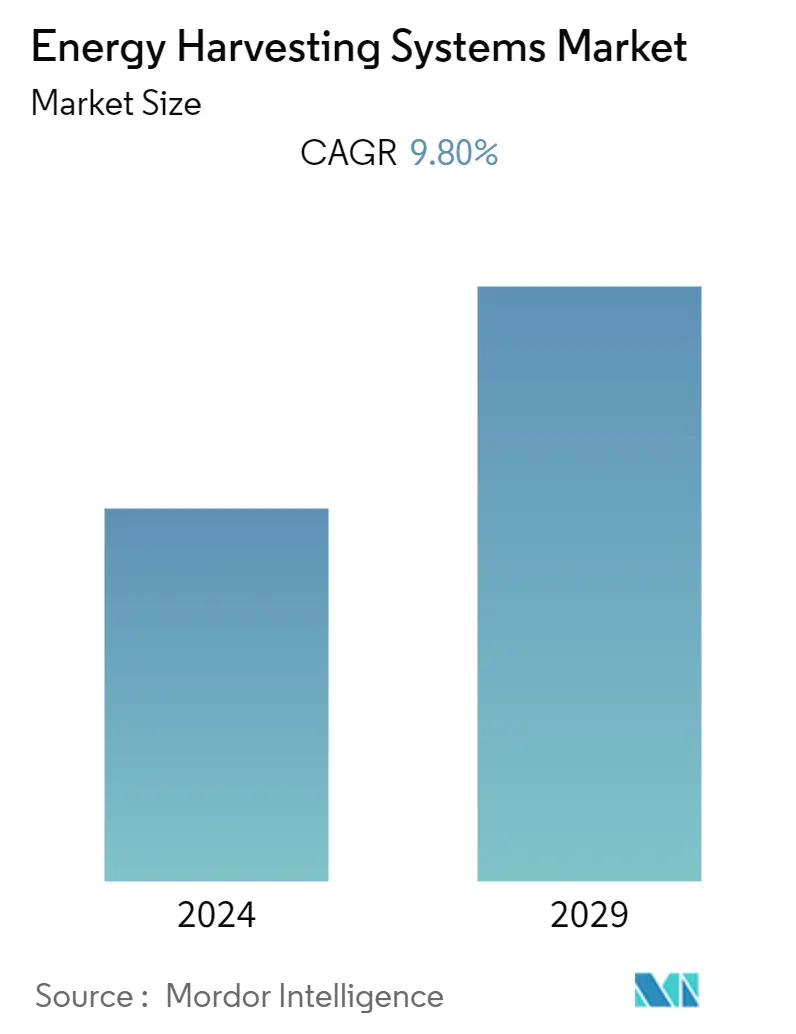
| Study Period | 2019 - 2029 |
| Base Year For Estimation | 2023 |
| CAGR | 9.80 % |
| Fastest Growing Market | Asia Pacific |
| Largest Market | North America |
| Market Concentration | Low |
Major Players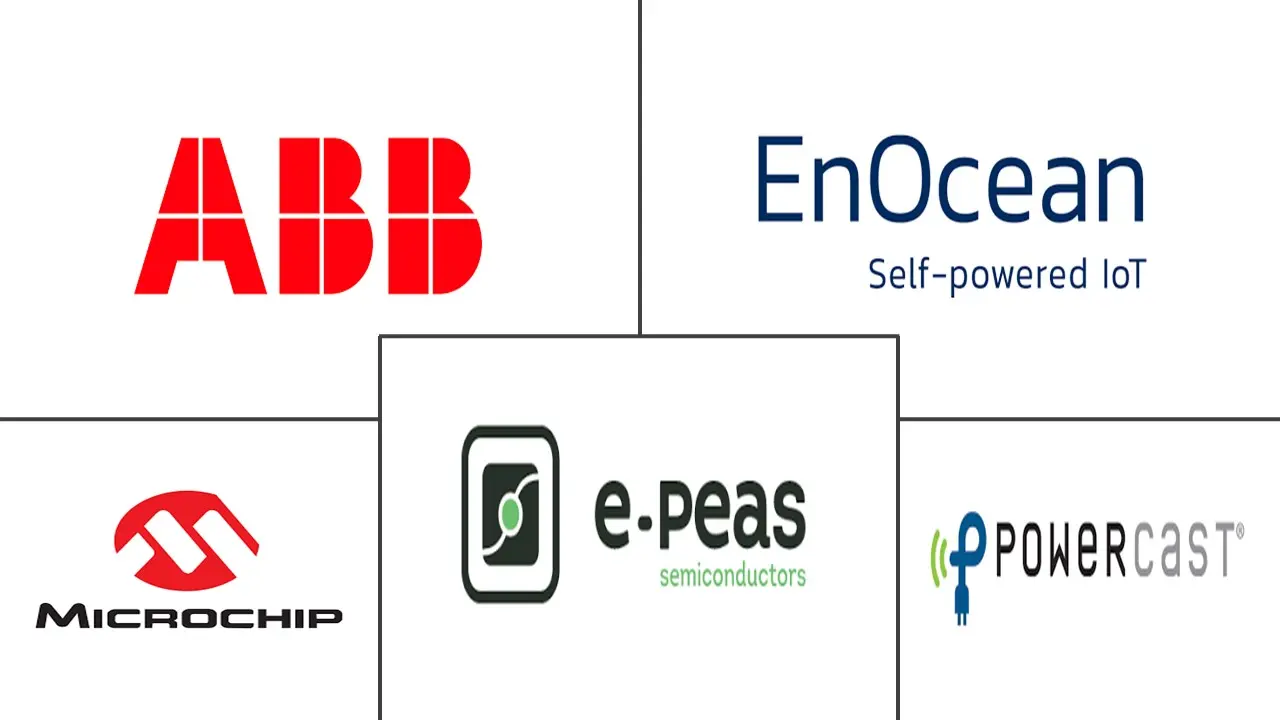
*Disclaimer: Major Players sorted in no particular order |
Energy Harvesting Systems Market Analysis
The Global Energy Harvesting Systems Market will register a CAGR of 9.8% over the forecast period. Energy harvesting, also known as power harvesting or energy scavenging, is the process by which energy is derived from external sources. Ambient energy, the energy source for energy harvesting systems, is present as ambient background and is freely available.
- The widespread use of IoT devices in automation, the expansion of urban areas, the rising demand for reliable, safe, and long-lasting systems, the increasing popularity of green energy, the widespread adoption of energy harvesting technology in building and home automation, and supportive government policies are all anticipated to contribute to the market's expansion during the forecast period.
- Energy harvesting systems are primarily used in low-power electrical utilities, such as sensors, watches, and home appliances. These systems provide an efficient alternative to conventional power sources, like batteries.
- Moreover, supportive government policies and increased awareness about the environment, along with the reduction in the emission of greenhouse gases, have helped raise the demand for such technologies.
- Using energy harvesting systems is advantageous since the connected devices can run for a very long time without causing adverse environmental effects. Additionally, the solar, thermal, and vibrational energy forms of energy are those that energy harvesting systems use the most frequently among the various sources of ambient energy, including light energy, thermal energy, radiofrequency energy, kinetic energy, chemical/biological energy, and others.
- The energy harvesting systems are also deployed in applications that require a backup battery, and primarily battery is located remotely at a difficult place to reach. The transmitters and receivers used in the energy harvesting systems should be installed close to each other for better signal transmission. Collecting data at the central receiver is difficult when these sensors are deployed in remote locations.
- Owing to the outbreak of the COVID-19 pandemic, the Chinese solar industry and its economy are reeling under the impact. The exports are yet to be gauged fully. Such delay would restrict the growth of the energy harvesting systems.
Energy Harvesting Systems Market Trends
This section covers the major market trends shaping the Energy Harvesting Systems Market according to our research experts:
Consumer Electronics to Hold Significant Market Share
- Energy harvesting systems are increasingly used in consumer electronics, such as wearables, smartphones, remote control units, wireless appliances, body implants, etc.
- Moreover, Energy harvesting systems allow consumer electronic products to operate where conventional power sources are unavailable. Such features extend the use and eliminate the geographical constraint for devices to always be near a power source. Such features are driving the use of energy harvesting systems in consumer electro.
- For instance, energy harvesting systems are used in remote control units, where power is harvested from the force applied by the user in pressing the button. Recently, ARM has built such a device with the low power of the ARM Cortex-M0+ processor.
- The energy captured may be used in most wireless applications, body implants, wearables, and other low-power consumption applications. Even if the harvested energy is not enough to power the entire device, it may still be used to extend the life of conventional batteries.
- For example, researchers from the Chinese University of Hong Kong have developed a device that may harvest energy from the human knee during walking without a substantial increase in effort for wearers. The demonstrated device generates up to 1.6 mW of power without significantly changing breathing patterns.
- The proliferation of connected devices and the need for less expensive and reliable energy sources drive the growth of energy harvesting systems in the consumer electronics industry.
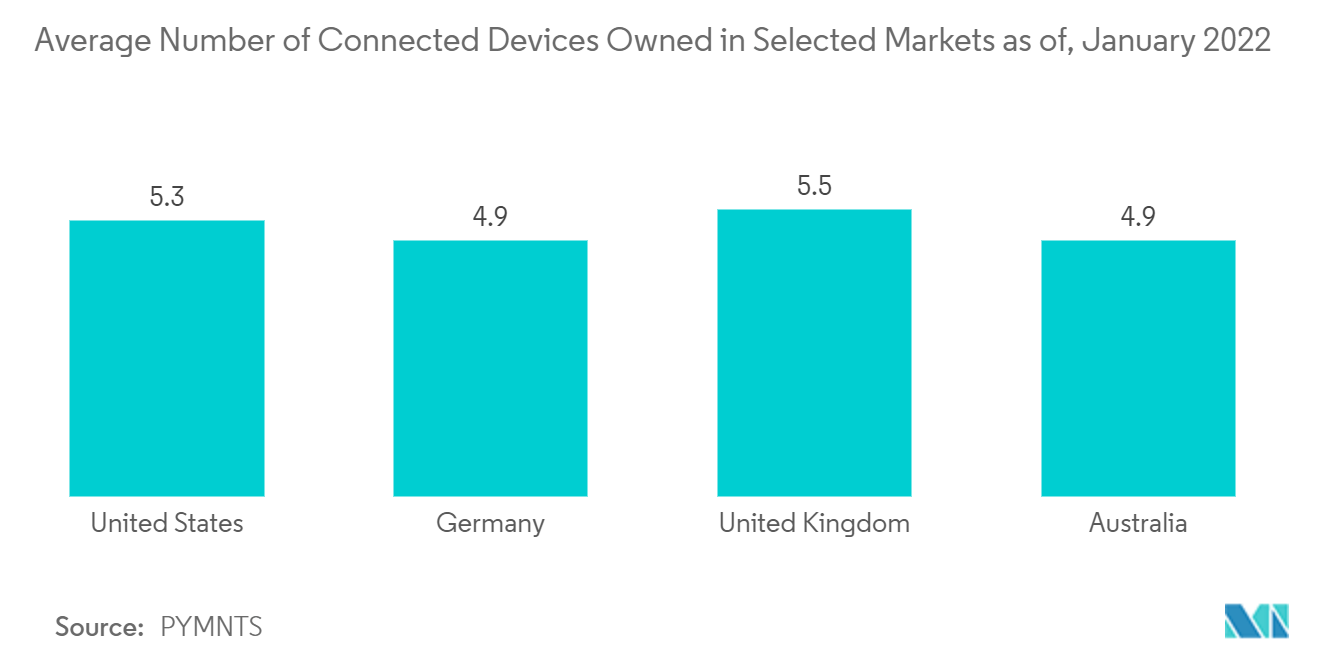
North America to Hold the Largest Market Share
- Due to the region's ongoing and rapid technical advancements, North America has emerged as the most critical market for investments in building and home automation, which employ renewable energy and propel the demand for energy harvesting systems.
- The majority of the region's revenue came from the United States. Due to the administration's intention to make the nation an energy-independent state and the thriving industrial and transportation sectors, the industry is anticipated to experience significant expansion.
- Comparatively to other markets, the North American market is seeing a high level of industrial IoT adoption, boosting the need for energy harvesting systems.
- Government programs to reduce energy emissions from outdated and public buildings have also contributed to this growth. For instance, 50 of the federal government's most energy-intensive buildings will have installed sophisticated and smart building technology due to a deal the U.S. General Services Administration signed with IBM.
- Additionally, the smart cities project launch has altered the local market environment. In addition to holding events to promote collaboration and knowledge sharing amongst cities, businesses, and colleges involved in creating smart cities around the nation, this effort also includes various grants and funding packages.
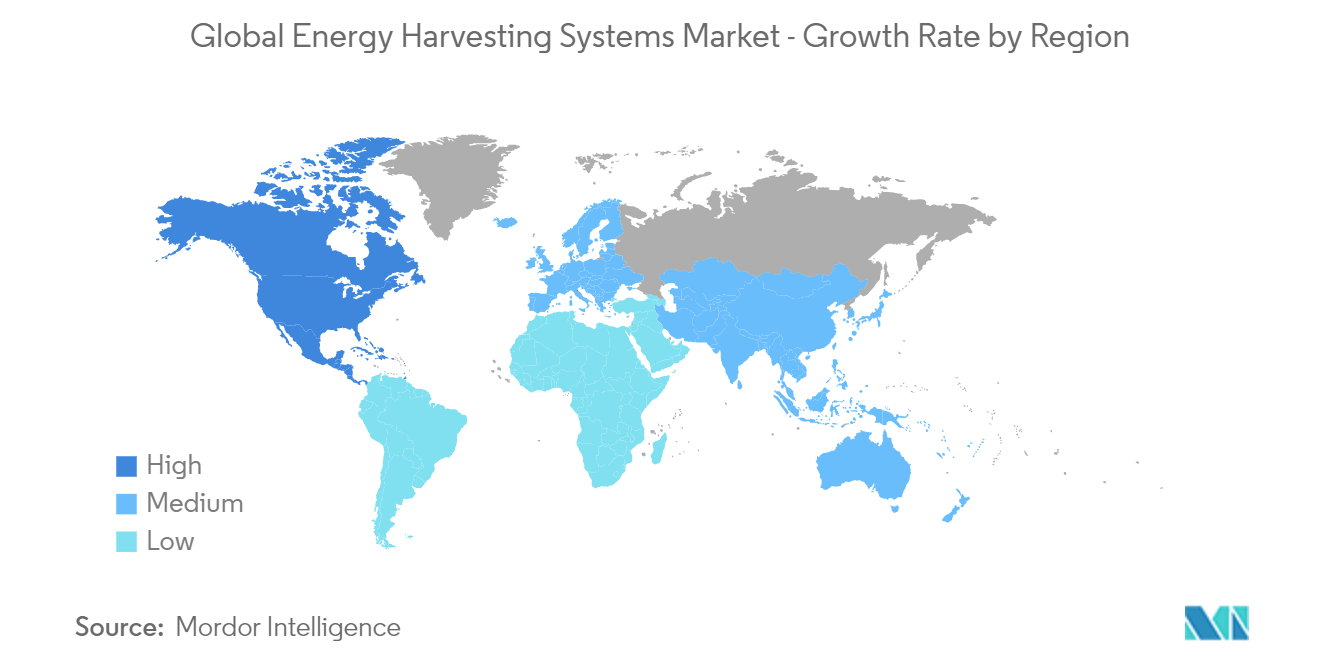
Energy Harvesting Systems Industry Overview
Energy Harvesting Systems Market is very competitive. Among others, ABB Limited and STMicroelectronics NV are the market's two biggest competitors. However, a few new entrants are drawing considerable investments into the industry due to significant advances in product lines.
In September 2022, E-Peas SA and Energous Corporation announced the launch of a new Wireless Energy Harvesting Evaluation Kit, developed for energy harvesting applications for smart buildings/smart homes, industrial IoT medical, and asset trackers for retail and warehouses. The kit includes the company's 1W WattUp PowerBridge transmitter, delivering an over-the-air solution that enables device manufacturers to implement wireless power and energy harvesting across a range of connected devices along with two evaluation boards from e-peas: the AEM30940 RF Evaluation Board and the EP112 Energy Harvesting Optimized Antenna Evaluation Board.
Energy Harvesting Systems Market Leaders
-
ABB limited
-
Microchip Technology Inc
-
E-Peas SA
-
Powercast Corporation
-
EnoCean GmbH
*Disclaimer: Major Players sorted in no particular order
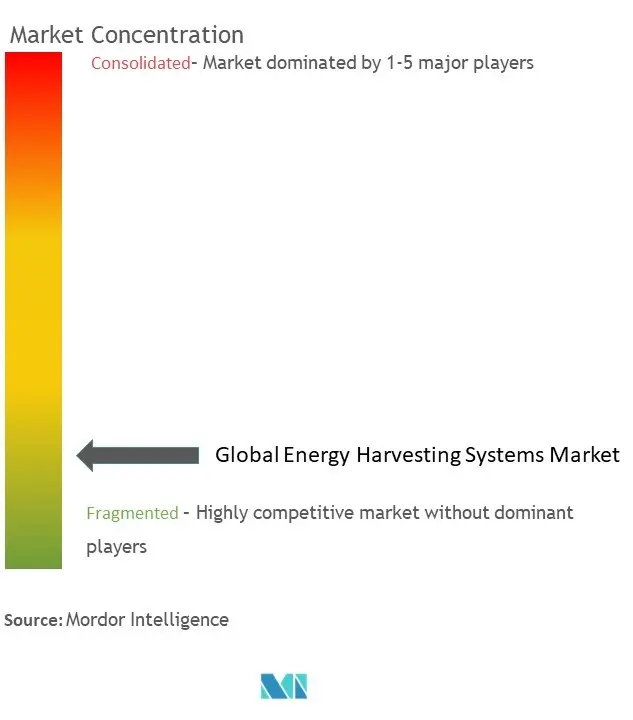
Energy Harvesting Systems Market News
- March 2022: Powercast Corporation announced that it had shipped 10 million wireless RF Powerharvester PCC110 chips in the previous two years. The company credits this achievement to the rising demand for wireless power-over-distance solutions that liberate gadgets from cables, batteries, and positioning constraints, such as the direct contact with a charging surface mandated by the Qi wireless charging standard. With the help of Powercast's technology, untethered devices can be powered remotely (up to 80 feet away), which reduces or eliminates the need for batteries and connections while boosting functionality and efficiency and allowing for more flexible device placement.
- January 2022: E-Peas SA announced the launch of an Ultra-Compact Custom Power Management Solution for Cartier's First Solar Energy Harvesting Watch, the Tank watch where. The ultra-compact PMIC specially developed for the Tank watch has dimensions of just 2mm x 2mm, making it smaller than any other energy harvesting solution currently available. The architecture only uses a few tiny external components enabling the total solution to fit into the constrained space open.
- January 2022: Advanced Linear Devices, Inc. (ALD) portfolio of products in analog semiconductors announced the nano-powder precision P-Channel EPAD MOSFET array. The future generation of products that need low-power applications and mostly-on operation are developed using the matched pair MOSFET circuit, which aids in energy harvesting with the products' efficiency. By streamlining the bias circuitry, this MOSFET maximizes power efficiency. The automotive, medical, transportation, robotics, and wireless product markets are among those that use the MOSFET array. These markets depend on self-contained power circuits and need to operate at shallow power levels for extended periods.
Energy Harvesting Systems Market Report - Table of Contents
1. INTRODUCTION
- 1.1 Study Assumptions and Market Definition
- 1.2 Scope of the Study
2. RESEARCH METHODOLOGY
3. EXECUTIVE SUMMARY
4. MARKET INSIGHTS
- 4.1 Market Overview
-
4.2 Industry Attractiveness - Porter Five Forces
- 4.2.1 Bargaining Power of Suppliers
- 4.2.2 Bargaining Power of Buyers
- 4.2.3 Threat of New Entrants
- 4.2.4 Threat of Substitutes
- 4.2.5 Intensity of Competitive Rivalry
- 4.3 Industry Value Chain Analysis
5. MARKET DYNAMICS
-
5.1 Market Drivers
- 5.1.1 Growth of Smart Cities
- 5.1.2 Technology Developments in Manufacturing Industries
-
5.2 Market Challenges
- 5.2.1 High Initial Costs
6. MARKET SEGMENTATION
-
6.1 By Technology
- 6.1.1 Light Energy Harvesting
- 6.1.2 Vibration Energy Harvesting
- 6.1.3 Thermal Energy Harvesting
- 6.1.4 RF Energy Harvesting
-
6.2 By Application
- 6.2.1 Consumer Electronics
- 6.2.2 Building and Home Automation
- 6.2.3 Industrial
- 6.2.4 Transportation
- 6.2.5 Other Applications
-
6.3 By Geography
- 6.3.1 North America
- 6.3.2 Europe
- 6.3.3 Asia Pacific
- 6.3.4 Rest of the World
7. COMPETITIVE LANDSCAPE
-
7.1 Company Profiles
- 7.1.1 Microchip Technology Inc.
- 7.1.2 E-Peas SA
- 7.1.3 EnoCean GmbH
- 7.1.4 ABB Limited
- 7.1.5 Powercast Corporation
- 7.1.6 Advanced Linear Devices Inc
- 7.1.7 Analog Devices Inc
- 7.1.8 STMicroelectronics NV
- 7.1.9 Texas Instruments Incorporated
- 7.1.10 Cypress Semiconductor Corporation
- 7.1.11 Piezo.com
- *List Not Exhaustive
8. INVESTMENT ANALYSIS
9. FUTURE OF THE MARKET
** Subject To AvailablityEnergy Harvesting Systems Industry Segmentation
Energy harvesting, also known as power harvesting or energy scavenging, is the process by which energy is derived from external sources. Ambient energy, the energy source for energy harvesting systems, is present as ambient background and is freely available.
The Global Energy Harvesting Systems Market is segmented by Technology (Light Energy Harvesting, Vibration Energy Harvesting, Thermal Energy Harvesting, and RF Energy Harvesting), Application (Consumer Electronics, Building, and Home Automation, Industrial, Transportation), and Geography.
The market sizes and forecasts are provided in terms of value (USD million) for all the above segments.
| By Technology | Light Energy Harvesting |
| Vibration Energy Harvesting | |
| Thermal Energy Harvesting | |
| RF Energy Harvesting | |
| By Application | Consumer Electronics |
| Building and Home Automation | |
| Industrial | |
| Transportation | |
| Other Applications | |
| By Geography | North America |
| Europe | |
| Asia Pacific | |
| Rest of the World |
Energy Harvesting Systems Market Research FAQs
What is the current Energy Harvesting Systems Market size?
The Energy Harvesting Systems Market is projected to register a CAGR of 9.80% during the forecast period (2024-2029)
Who are the key players in Energy Harvesting Systems Market?
ABB limited, Microchip Technology Inc, E-Peas SA, Powercast Corporation and EnoCean GmbH are the major companies operating in the Energy Harvesting Systems Market.
Which is the fastest growing region in Energy Harvesting Systems Market?
Asia Pacific is estimated to grow at the highest CAGR over the forecast period (2024-2029).
Which region has the biggest share in Energy Harvesting Systems Market?
In 2024, the North America accounts for the largest market share in Energy Harvesting Systems Market.
What years does this Energy Harvesting Systems Market cover?
The report covers the Energy Harvesting Systems Market historical market size for years: 2019, 2020, 2021, 2022 and 2023. The report also forecasts the Energy Harvesting Systems Market size for years: 2024, 2025, 2026, 2027, 2028 and 2029.
Energy Harvesting Systems Industry Report
Statistics for the 2024 Energy Harvesting Systems market share, size and revenue growth rate, created by Mordor Intelligence™ Industry Reports. Energy Harvesting Systems analysis includes a market forecast outlook to 2029 and historical overview. Get a sample of this industry analysis as a free report PDF download.



